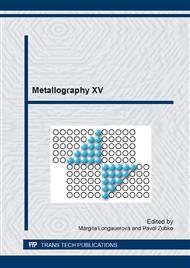p.284
p.288
p.295
p.301
p.306
p.311
p.319
p.325
p.331
Laser Hardening Parameters Influencing Component Lifetime and Residual Stresses
Abstract:
Laser surface hardening is an advanced method of surface treatment of structural steels with a great potential for wide industrial applications. The technology is quite new and so, investigations have to be performed in order to gain a comprehensive knowledge about effects on microstructure, hardness, surface properties of treated materials, but also mechanical an particularly fatigue properties. Concerning fatigue resistance of material treated with this technology, results and knowledge recently published in the literature indicate that fatigue resistance can be either reduced or increased, even considerably, depending on numerous parameters of basic material, laser hardening parameters etc. This contribution contains results of a partial study of effect of laser hardening of relatively small specimens on fatigue resistance of 42CrMo4 steel. Two different parameters of the treatment were used, namely two speeds of laser beam on the material surface at constant beam energy. Unlike the lower speed, when fatigue resistance was slightly reduced, higher speed of laser beam resulted in a slight increase of fatigue resistance and fatigue limit. The results are discussed considering an occurrence of residuals stresses. Key words: Laser hardening, residual stress, lifetime, fatigue, fracture, microstructure, surface
Info:
Periodical:
Pages:
306-310
Citation:
Online since:
April 2014
Authors:
Keywords:
Price:
Сopyright:
© 2014 Trans Tech Publications Ltd. All Rights Reserved
Share:
Citation:


